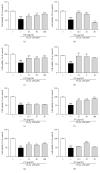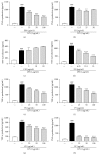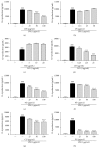Quantitative Analysis and Biological Efficacies regarding the Neuroprotective and Antineuroinflammatory Actions of the Herbal Formula Jodeungsan in HT22 Hippocampal Cells and BV-2 Microglia
- PMID: 29391873
- PMCID: PMC5748148
- DOI: 10.1155/2017/6360836
Quantitative Analysis and Biological Efficacies regarding the Neuroprotective and Antineuroinflammatory Actions of the Herbal Formula Jodeungsan in HT22 Hippocampal Cells and BV-2 Microglia
Abstract
Jodeungsan (JDS) is a traditional herbal formula that comprises seven medicinal herbs and is broadly utilized to treat hypertension, dementia, and headache. However, the effects of JDS and its herbal components on neurodegenerative diseases have not been reported. We examined the inhibitory effects of JDS and its seven components on neuronal cell death and inflammation using HT22 hippocampal cells and BV-2 microglia, respectively. Among its seven herbal components, Uncaria sinensis (US), Chrysanthemum morifolium (CM), Zingiber officinale (ZO), Pinellia ternata (PT), Citrus unshiu (CU), and Poria cocos (PC) exhibited significant neuroprotective effects in HT22 cells. In BV-2 cells, JDS significantly suppressed the production of tumor necrosis factor-alpha (TNF-α) and interleukin-6 (IL-6), indicating the antineuroinflammatory activity of JDS. In addition, the herbal extracts from ZO, Panax ginseng (PG), PT, CU, and PC exhibited inhibitory effects on the inflammatory response in microglia. These data imply that the JDS effect on neurodegeneration occurs via coordination among its seven components. To establish a quality control for JDS, a simultaneous analysis using five standard compounds identified hesperidin (37.892 ± 1.228 mg/g) as the most abundant phytochemical of JDS. Further investigation of the combinatorial activities of two or more standard compounds will be necessary to verify their antineurodegenerative regulatory mechanisms.
Figures





References
LinkOut - more resources
Full Text Sources
Other Literature Sources

